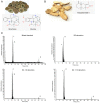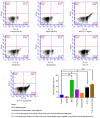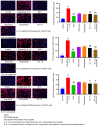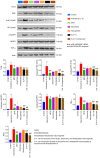Effect of a combination of Atractylodes macrocephala extract with strychnine on the TLR4/NF-κB/NLRP3 pathway in MH7A cells
- PMID: 36761010
- PMCID: PMC9905656
- DOI: 10.3892/etm.2023.11791
Effect of a combination of Atractylodes macrocephala extract with strychnine on the TLR4/NF-κB/NLRP3 pathway in MH7A cells
Abstract
Rheumatoid arthritis (RA) is now widely recognized as a chronic systemic inflammatory autoimmune disease characterized by swelling, pain and stiffness, which are often disabling. Although the number of drugs available for the treatment of RA has increased in recent years, they are generally expensive, leave patients prone to relapse and can result in severe effects when discontinued. Thus, there is a need for an inexpensive drug with fewer side effects that can be adhered to relieve pain and slow down the progression of the disease. Strychnine, a traditional Chinese medicine, was often used in ancient times to treat swollen and painful joints; however, because of its somewhat toxic nature, it is often combined with Atractylodes macrocephala to reduce its toxicity for safer therapeutic action. The present study performed high-performance liquid chromatography (HPLC)-tandem mass spectrometry (MS/MS) analysis to confirm whether the use of strychnine with Atractylodes macrocephala had the effect of reducing strychnine content. MH7A cells were induced using IL-1β to study the effect of strychnine with Atractylodes macrocephala on the Toll-like receptor 4 (TLR4)/NF-κB/NLR family pyrin domain-containing 3 (NLRP3) pathway in order to verify its role in the treatment of RA. The results indicated that the combined application of HPLC-MS/MS strychnine and Atractylodes macrocephala had a reducing effect on the strychnine content. From the subsequent experimental results, it can be inferred that Strychnine combined with Atractylodes macrocephala extract could promote the apoptosis of synovial cells, and could inhibit the expression levels of TLR4, NF-κB and NLRP3 in the cells as well as reducing the MH7A-positive cells. The expression levels of TLR4, IκB kinase β, NF-κB and NLRP3 were significantly reduced after treatment with each administration group, resulting in a decrease in the phosphorylation levels of TLR4 and NF-κB, indicating that the combination potently inhibited their phosphorylation. The combination of strychnine and atractylenolide II was also revealed to be the main active ingredient in the treatment of RA.
Keywords: Atractylodes macrocephala; MH7A cells; NF-κB; NLR family pyrin domain-containing 3; Toll-like receptor 4; brucine; rheumatoid arthritis; strychnine.
Copyright: © Gao et al.
Conflict of interest statement
The authors declare that they have no competing interests.
Figures








Similar articles
-
Inhibition of the Akt/NF-κB pathway is involved in the anti-gastritis effects of an ethanolic extract of the rhizome of Atractylodes macrocephala.J Ethnopharmacol. 2022 Jul 15;293:115251. doi: 10.1016/j.jep.2022.115251. Epub 2022 Apr 2. J Ethnopharmacol. 2022. PMID: 35381310
-
Study on the pharmacodynamics and metabolomics of five medicinal species in Atractylodes DC. on rats with rheumatoid arthritis.Biomed Pharmacother. 2020 Nov;131:110554. doi: 10.1016/j.biopha.2020.110554. Epub 2020 Sep 2. Biomed Pharmacother. 2020. PMID: 32890964
-
Strychni Semen Combined with Atractylodes Macrocephala Koidz Attenuates Rheumatoid Arthritis by Regulating Apoptosis.Curr Comput Aided Drug Des. 2024;20(5):518-533. doi: 10.2174/1573409919666230807154555. Curr Comput Aided Drug Des. 2024. PMID: 37550914
-
The traditional uses, phytochemistry, and pharmacology of Atractylodes macrocephala Koidz.: A review.J Ethnopharmacol. 2018 Nov 15;226:143-167. doi: 10.1016/j.jep.2018.08.023. Epub 2018 Aug 18. J Ethnopharmacol. 2018. PMID: 30130541 Review.
-
Efficacy and safety of Atractylodes macrocephala-containing traditional Chinese medicine combined with neoadjuvant chemotherapy in the treatment of advanced gastric cancer: a systematic evaluation and meta-analysis.Front Oncol. 2024 Oct 16;14:1431381. doi: 10.3389/fonc.2024.1431381. eCollection 2024. Front Oncol. 2024. PMID: 39479020 Free PMC article.
Cited by
-
Brucine Inhibits Proliferation of Pancreatic Ductal Adenocarcinoma through PI3K/AKT Pathway-induced Mitochondrial Apoptosis.Curr Cancer Drug Targets. 2024;24(7):749-759. doi: 10.2174/0115680096274284231116104554. Curr Cancer Drug Targets. 2024. PMID: 38310464
-
Atractylenolide II regulates the proliferation, ferroptosis, and immune escape of hepatocellular carcinoma cells by inactivating the TRAF6/NF-κB pathway.Naunyn Schmiedebergs Arch Pharmacol. 2024 Oct;397(10):7697-7710. doi: 10.1007/s00210-024-03046-2. Epub 2024 May 6. Naunyn Schmiedebergs Arch Pharmacol. 2024. PMID: 38709266
-
Ondansetron or beta-sitosterol antagonizes inflammatory responses in liver, kidney, lung and heart tissues of irradiated arthritic rats model.Int J Immunopathol Pharmacol. 2024 Jan-Dec;38:3946320241260635. doi: 10.1177/03946320241260635. Int J Immunopathol Pharmacol. 2024. PMID: 38831558 Free PMC article.
-
New Potentiality of Bioactive Substances: Regulating the NLRP3 Inflammasome in Autoimmune Diseases.Nutrients. 2023 Oct 28;15(21):4584. doi: 10.3390/nu15214584. Nutrients. 2023. PMID: 37960237 Free PMC article. Review.
References
-
- Kotake S, Sato K, Kim KJ, Takahashi N, Udagawa N, Nakamura I, Yamaguchi A, Kishimoto T, Suda T, Kashiwazaki S. Interleukin-6 and soluble interleukin-6 receptors in the synovial fluids from rheumatoid arthritis patients are responsible for osteoclast-like cell formation. J Bone Miner Res. 1996;11:88–95. doi: 10.1002/jbmr.5650110113. - DOI - PubMed
LinkOut - more resources
Full Text Sources
